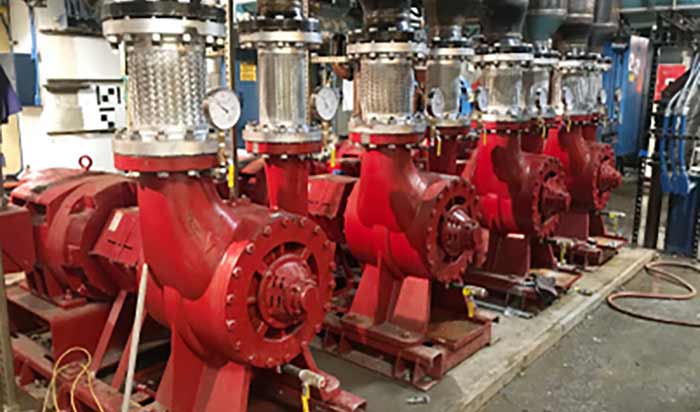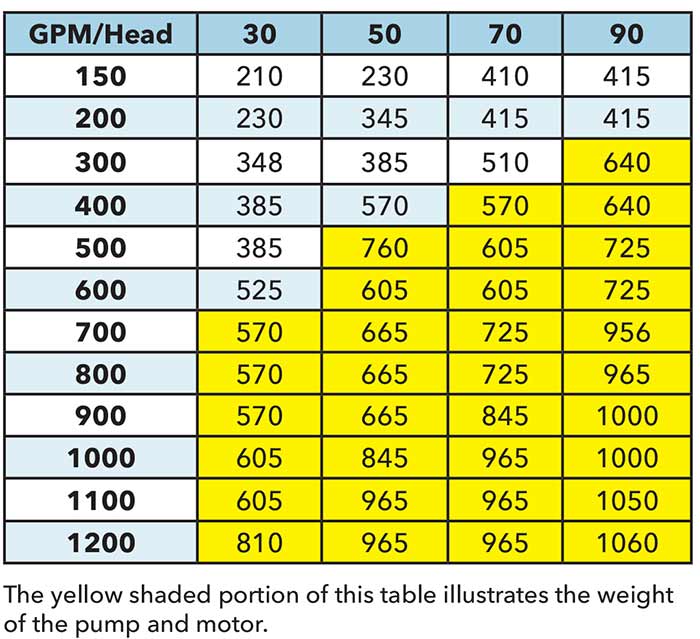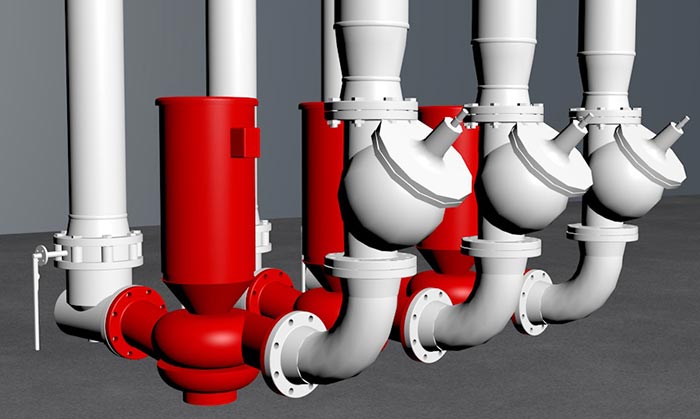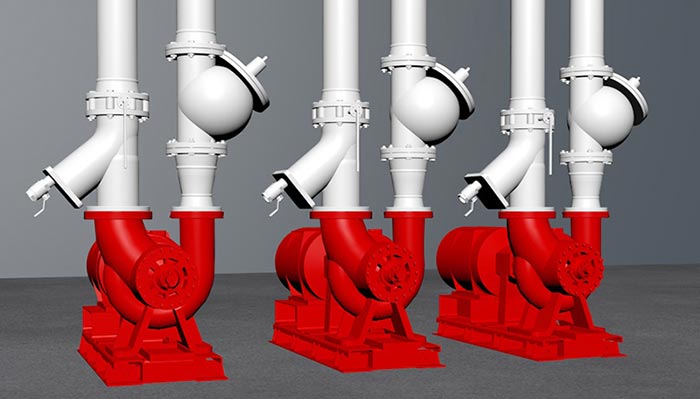In commercial building hydronic heating, ventilation and air conditioning (HVAC) applications that require pumps of 10 horsepower (hp) or more, pumping capacity is not the only criterion that influences pump selection. The style of pump—vertical inline (VIL) or base mounted—should be evaluated in terms of energy and operational costs, along with its ability to minimize the footprint of the total system installation. The way for engineers and facility operators to choose the best system that delivers on the building owner’s objectives—keeping costs to a minimum and leasable space to a maximum—is to consider the HVAC system as a whole and the contribution of each component. From that foundation, it is useful to examine the benefits and costs of both VIL and base-mounted pumps.
 Image 1. To conserve space, VIL pumps tend to be spaced close together, which can pose problems for accessibility. (Images courtesy of Bell & Gossett)
Image 1. To conserve space, VIL pumps tend to be spaced close together, which can pose problems for accessibility. (Images courtesy of Bell & Gossett)Footprint Considerations
There is a general misconception in the market that the installed footprint of VIL pumps is much smaller than base-mounted pumps. This can be true in some smaller horsepower applications, such as boiler pumps (smaller hydronic system), but it does not necessarily apply across the board. It is important to think about the footprint of the total installation, instead of solely the pump itself. Using this approach, any space advantage of installing VIL pumps can become negligible. Smaller VIL pumps mounted in the piping can create some space savings. But overall, base-mounted pumps can be the better choice for applications involving pumps larger than 10 to 15 hp. Base-mounted pumps can present a lower installation cost, energy savings, increased reliability, easier maintenance and smaller installed footprint. In fact, there are cases where base-mounted end-suction pump installations use less floor space than VIL—notably as the size of the pump increases. The VIL pump’s footprint may not be ideal for pump/drive combinations. The National Electrical Code (NEC) calls for 3 to 4 feet of clearance in front of the drive. This can eliminate the space advantage for VIL pumps in the context of the complete installation. Image 2. Pump and motor weight based on flow and head
Image 2. Pump and motor weight based on flow and headMaintenance Considerations
Ongoing pump maintenance is based on a number of factors, including mechanical seal replacement and an ability to service the pump without disturbing the piping. One end-suction centrifugal pump has a function that means the motor does not have to be moved for maintenance. While mechanical seal replacement in VIL pumps is a relatively easy procedure, there is more to total service. This comprises replacement of the throttle bushing, impeller and pump shaft. In most cases, the motor must be removed, requiring space and sometimes hoisting equipment, even with a relatively small pump. Depending on where the VIL pump is installed within the system, it may need to be removed and lowered from the piping at the ceiling to the ground for safe servicing. This can add more maintenance downtime. To conserve space, VIL pumps tend to be spaced close together, which can pose accessibility issues. It can be challenging, time consuming and pose a safety hazard for technicians to work on a large VIL pump between two others that continue to operate at full speed. One pump may need to be shut down, forfeiting redundancy and risking adequate capacity. Service access in a base-mount installation is straightforward because the layout of the system enables easier access. Image 3. Life expectancy of base-mounted pump vs. pipe-mounted (VIL) pumps (per ASHRAE)
Image 3. Life expectancy of base-mounted pump vs. pipe-mounted (VIL) pumps (per ASHRAE)Pump Life Expectancy
Base-mounted pumps can have greater reliability, extending product life. The mechanical seals in VIL pumps need external flushing tubes that can be vulnerable to damage and can plug over time, leading to premature seal failures and lower life expectancy. Base-mounted pumps have internal flushing capability that can pass up to three times more flow over the seal faces, helping reduce seal temperature. In addition, some base-mounted pumps have two sets of bearings—one set for the thrust and radial load, and one set for the motor, reducing wear and tear. VIL pumps have only a motor bearing, which may reduce total life. The American Society of Heating, Refrigerating and Air-Conditioning Engineers (ASHRAE) Equipment Life Expectancy Chart shows the longevity of base-mounted pumps. Image 4. Maintenance access is a key consideration when designing a system for a specific mechanical room layout.
Image 4. Maintenance access is a key consideration when designing a system for a specific mechanical room layout. Vibration, Support Factors
The rotating elements within a pump cause vibration. Both base-mounted and VIL pumps have motors and impellers that rotate, and both pumps are designed and manufactured to the same vibration standard (ANSI/HI 9.6.4). ANSI/HI 1.1-1.5, Centrifugal Pumps, for Nomenclature, Definitions, Application & Operation cites seven possible sources of vibration in pumps:- recirculation radial forces at low flows
- fluid separation at high flows
- cavitation due to net positive suction head (NPSH)
- air entrainment or aeration of the liquid
- hydraulic resonance in the piping
- solids contained in the liquid
- wear of rotating components
 Image 5. Base-mounted pumps take up less space in a mechanical room, and less piping is required for reduced installation cost.
Image 5. Base-mounted pumps take up less space in a mechanical room, and less piping is required for reduced installation cost.
